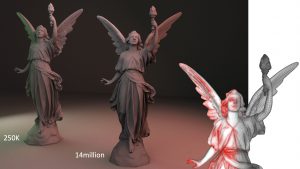What is SIGGRAPH Asia?
SIGGRAPH or the Special Interest Group on Computer Graphics and Interactive Techniques, is conference held for all technologies related to 3D and computer graphics. The main conference is usually held in North America, while the Asian conference rotates around a different Asian country each year. There are many different types of exhibitions from technical papers, to 3D animation to VR to art. If it has to do with computer graphics you can find it at SIGGRAPH!
Reference: https://sa2021.siggraph.org/jp/
What relationship does it have to the CAD industry?
While the CAD industry may not always seem on the cutting edge of technology, improvements to current rendering techniques can have a big impact of performance. Improvements to performance allow for larger more complicated models, on smaller or more mobile devices. In addition emerging technologies such as VR and AR have new applications to current roles in Smart Factories and similar systems. I have selected a few things that I thought were particularly interesting from this year’s SIGGRAPH Asia to share with you.
Saliency-based Mesh Compression
Image Source: https://www.wgtn.ac.nz/cmic/research/future-studio-solution
My personal favorite from this year’s exhibition was brought forward by a team at the Victoria University of Wellington. They proposed a solution for automated mesh compression based on the mesh’s saliency. Saliency is the act of finding how important a particular polygon is to a mesh based on its flatness or curviness. Areas with more curves are seen as more salient and thus more important. Areas with less curves are more flat and thus less important and can be compressed. This allows for meshes to keep detail in more important while reducing the overall size greatly improving performance. While the concept of saliency has been around for a while, there is yet to exist an automated solution. I find this particularly interesting for the CAD industry as it would allow finer detail for Bezier curves while keeping models small. All without any need to adjust geometry from the designer!
Reference: https://www.wgtn.ac.nz/cmic/research/future-studio-solution
Depth-Aware Dynamic Projection Mapping
Another impressive piece of technology was the Depth-Aware Dynamic Projection Mapping presented by WATANABE Lab/ Tokyo Tech. By combining Ray-Tracing and updates with IR Cameras they are able to replicate real-world motion in real time and project a map onto an object. What makes this technology even more impressive is the fact that it is marker-less! While the quality of the image and background of projector leave some improvements to be desired for real-world applications, the technology itself is very impressive.
Reference: http://www.vision.ict.e.titech.ac.jp/projects/PathtracingDPM/index.html
X-Wing: Propeller-Based Force Feedback VR
My final choice of interesting exhibitions was the X-Wing: Propeller-Based Force Feedback VR headset by researchers at Keio University. By attaching ducted fans to a VR headset they enable the acting of forces upon the head in a VR experience. This allows the user to feel wind while flying as if a bird, but I believe its applications to be very wide as the input could also guide the user in which direction to look. I also noticed many emergency personal at this booth, and I’m sure in simulations of burning buildings and other training simulations the ability to simulate wind and moving air could be very helpful.
Reference: https://dl.acm.org/doi/abs/10.1145/3478514.3487622
Other Interesting Presentations
Some other interesting exhibitions I saw but will not go in depth into, were some improvements into toon shading. New ways to experience movies through VR and some viewer interaction. Free floating 3D images and much much more.
Summary
SIGGRAPH is an excellent opportunity for people from all industries to see the latest in graphics technology. I highly recommend anyone who has not had the opportunity to do so to check it out.


